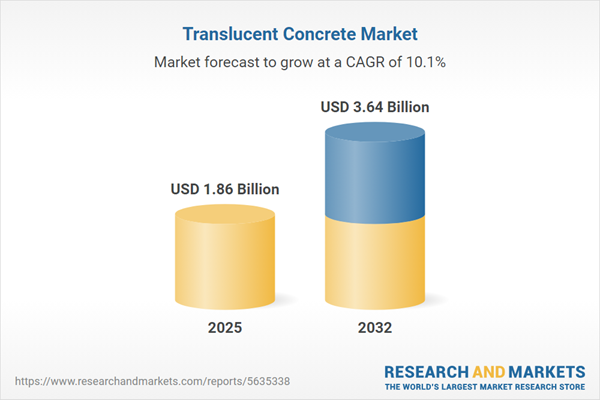Speak directly to the analyst to clarify any post sales queries you may have.
Translucent concrete is reshaping modern building approaches by bringing together structural durability and the natural illumination of daylight. As senior decision-makers seek innovative paths to both visual distinction and efficiency across project types, the market for translucent concrete offers a compelling opportunity to meet emerging performance and design expectations.
Market Snapshot: Translucent Concrete Market Size and Growth
The translucent concrete market expanded from USD 1.68 billion in 2024 to USD 1.86 billion in 2025, maintaining a CAGR of 10.09% and projected to reach USD 3.64 billion by 2032. This robust progression reflects intensifying demand for building solutions that prioritize energy savings, aesthetics, and innovative functions. Decision-makers across development sectors are leveraging this growth to differentiate assets and adapt to shifting industry standards, emphasizing solutions that address environmental and operational imperatives. As regulations and sustainability targets intensify, transparent and semitransparent concrete structures are becoming vital to projects seeking to balance unique design requirements with measurable efficiency improvements.
Scope & Segmentation
This report examines the translucent concrete market through an in-depth segmentation approach to inform leaders on evolving priorities and growth drivers.
- Product Types: Fiber optic concrete, hybrid panels, light transmitting blocks, luminescent concrete—each providing alternatives for customized translucency and modularity.
- Applications: Exterior uses including facades, walkways, and core structural elements; interior applications for ceilings, floors, and walls, facilitating integrated daylighting and ambiance design.
- End Users: Commercial sectors such as healthcare, hospitality, and retail; critical infrastructure—including bridges, tunnels, and public spaces; and residential construction across both single and multifamily developments.
- Technologies: Electroluminescent, fiber optic, and photoluminescent systems—each presenting varied benefits in efficiency, maintenance profiles, and architectural flexibility.
- Installation: Applicable to new builds, renovation of commercial spaces, and residential upgrades where daylighting and material aesthetics are prioritized.
- Distribution Channels: Direct sales, distributors, e-commerce platforms, and manufacturer websites allow for scalable procurement and broad market reach.
- Regional Focus: Significant adoption is evident across Americas, Europe, Middle East, Africa, and Asia-Pacific regions, with local codes, incentives, and climatic conditions shaping the pace of technology deployment and market penetration.
- Leading Companies: Market presence is led by LiTraCon GmbH, LUCEM GmbH, Holcim Ltd, HeidelbergCement AG, and CEMEX S.A.B. de C.V., each advancing segment innovation and resilience.
Key Takeaways for Senior Decision-Makers
- Rising pursuit of daylight-optimized structures fuels adoption across both public and private construction segments, positioning translucent concrete as a strategic material for next-generation projects.
- Innovations in fiber optic and luminescent technologies are driving new solutions that blend aesthetics with the functional demand for integrated lighting and lower energy use.
- Specification requirements differ across sectors: commercial properties favor customization and branding potential, infrastructure projects demand large-format modules, and residential builds seek improved occupant comfort and value.
- Diversification of technology offerings enables the tailoring of solutions to suit a wide array of applications—exterior cladding, wayfinding installations, and bespoke interiors.
- Regional uptake varies due to policy drivers, building regulations, and local climate, requiring careful evaluation of deployment strategies and market entry timing.
- Major suppliers are allocating resources towards strategic alliances, digital process integration, and advanced R&D to strengthen supply chains, streamline installation, and elevate product performance in response to competitive pressures.
Tariff Impact & Supply Chain Adaptations
Recent United States tariff adjustments have directly influenced the import costs of specialized optical fibers and critical additives used in translucent concrete production. Manufacturers have responded by adopting inventory management strategies, securing alternative or domestic supplier relationships, and updating risk management protocols for large-scale development projects. These measures aim to minimize exposure to future disruptions and rising material costs while maintaining project timelines and budgets. Industry stakeholders continue to advocate for favorable policy recognition of sustainable building materials, and exemptions for advanced construction technologies remain central to resilience strategies as market complexity evolves.
Methodology & Data Sources
This analysis utilizes a blended methodology, combining expert interviews with architects, engineers, and materials scientists, plus secondary research from industry literature, technical standards, and regulatory publications. Peer review and data triangulation support actionable, reliable insights for the strategic decision-making process.
Why This Report Matters
- Provides executive guidance and detailed risk-opportunity mapping in the translucent concrete sector, supporting effective resource allocation and market entry or expansion decisions.
- Enables leadership teams to fine-tune procurement, design, and investment priorities by highlighting segmented growth dynamics, regional policy influences, and emerging technological capabilities.
- Equips buyers and strategists with up-to-date intelligence on supply chain adaptations, innovation trends, and steps for capitalizing on sustainability-driven incentives within the evolving global construction landscape.
Conclusion
Translucent concrete provides a strategic foundation for visually innovative, sustainable construction. Forward-looking decision-makers who pivot alongside these evolving advances stand to gain a significant market position as new project requirements emerge.
Additional Product Information:
- Purchase of this report includes 1 year online access with quarterly updates.
- This report can be updated on request. Please contact our Customer Experience team using the Ask a Question widget on our website.
Table of Contents
3. Executive Summary
4. Market Overview
7. Cumulative Impact of Artificial Intelligence 2025
List of Figures
Samples

LOADING...
Companies Mentioned
The key companies profiled in this Translucent Concrete market report include:- LiTraCon GmbH
- LUCEM GmbH
- Holcim Ltd
- HeidelbergCement AG
- CEMEX S.A.B. de C.V.
Table Information
| Report Attribute | Details |
|---|---|
| No. of Pages | 180 |
| Published | October 2025 |
| Forecast Period | 2025 - 2032 |
| Estimated Market Value ( USD | $ 1.86 Billion |
| Forecasted Market Value ( USD | $ 3.64 Billion |
| Compound Annual Growth Rate | 10.0% |
| Regions Covered | Global |
| No. of Companies Mentioned | 6 |









